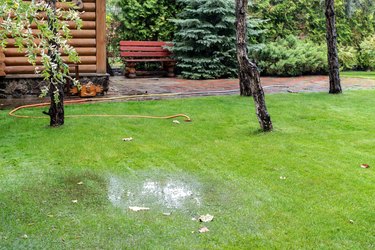
The unfortunate truth is that most homeowners have had to deal with (or will have to deal with) yard drainage issues at some point. Most drainage problems happen because the yard doesn't have enough slope to allow rainwater to run off, so you end up with standing pools of water. It's important to identify the cause so you can tackle the problem as effectively as possible. That being said, contacting a landscaping professional will save you valuable time and energy, so don't hesitate to do so.
Improve the Grade of Your Yard
Video of the Day
The most common cause of backyard drainage issues is an inadequate yard slope or pitch. If your yard doesn't have the appropriate slope, water can pool in one area of the yard or along the foundation of your house. Since it's preferable to have runoff water flow away naturally (rather than immediately resorting to a French drain, for example), consider improving the grade of your yard by spreading topsoil in low areas and along the foundation, which will help facilitate drainage. If this doesn't work, the next step might involve a French drain, dry well, or some other type of landscape drainage.
Video of the Day
Install a Dry Well
If, post-storm, your yard experiences flooding that soaks into the ground fairly quickly, you could consider installing a dry well (essentially a collection area for excess water) to help draw water away from low spots. A dry well is often used to handle excess water from one or more gutter downspouts. It includes a gravel-filled trench containing drainage pipe, which carries water from the downspout to a pit containing a perforated barrel that is surrounded by gravel. Water collects in the barrel and gradually seeps into the surrounding soil. The entire system is underground and can be covered with grass so it's invisible.
Build a Rain Garden
Another way to combat poor yard grading is to install a rain garden. A rain garden can be as big or small as you want it to be, and you could even create multiple rain gardens throughout your yard. Locate a spot at least 10 feet away from the house in a low area where the water collects. Then, dig out your garden and fill it with a mix of native plants that can tolerate periodic flooding.
Excess water is naturally channeled to the basin area of the rain garden, which is filled with plants that take up some of the water over time. The basin also serves as a holding pond and lets water filter down through the soil and return to the water table, rather than being dumped into the municipal storm sewer system.
Check Your Downspouts and Gutters
Your downspouts and gutters may be causing rain water to stay in one area instead of being diverted away from the house. In this case, you could consider either routing your downspout into a dry creek bed or installing a French drain to move water runoff to a curbside storm drain. Be sure to check your gutters for blockages, as well, and clean them as needed.
Getting Help From a Pro
Whatever is causing your backyard drainage problems, it's important to remedy the issue as soon as possible. Contact a landscaping professional to examine your property and diagnose the issue, especially if drainage problems persist. A consultation with a pro will help you understand what's going on so you can effectively address the issue at hand.